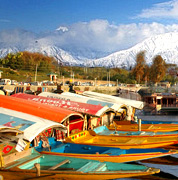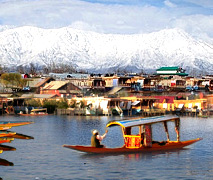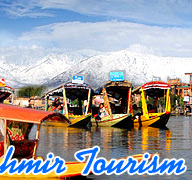 Mountain climbing is one of the most popular
adventure sports of Jammu and Kashmir. Boasting of some of the best
peaks of Himalayan and Alpine mountain ranges, the four regions into
which the mountains can be grouped are - Kashmir, Kishtwar, Zanskar and
Ladakh. The best renowned peaks are Kolahoi at an altitude of 5,425 m
above sea level, known as the Matterhorn of Kashmir; Harmukh at an
altitude of 5,148 m above sea level, whose north face resembles Eiger;
Tattakuti at an altitude of 4,742 m above sea level; Sunset at an
altitude of 4,745 m above sea level, the highest peak in the Pir Panjal
range, and numerous other mall peaks in Sonamarg and Pahalgam.
Mountain climbing is one of the most popular
adventure sports of Jammu and Kashmir. Boasting of some of the best
peaks of Himalayan and Alpine mountain ranges, the four regions into
which the mountains can be grouped are - Kashmir, Kishtwar, Zanskar and
Ladakh. The best renowned peaks are Kolahoi at an altitude of 5,425 m
above sea level, known as the Matterhorn of Kashmir; Harmukh at an
altitude of 5,148 m above sea level, whose north face resembles Eiger;
Tattakuti at an altitude of 4,742 m above sea level; Sunset at an
altitude of 4,745 m above sea level, the highest peak in the Pir Panjal
range, and numerous other mall peaks in Sonamarg and Pahalgam. Kishtwar presents small but challenging Himalayan peaks with great technical difficulty and involve weeklong trekking to the base camps. The popular peaks in this region are Sickle Moon at an altitude of 6,575 m above sea level; Eiger at an altitude of 6,001 m above sea level; Brammah-I at an altitude of 6,416 m above sea level; Brammah's Wife at an altitude of 5,297 m above sea level; Crooked Finger at an altitude of 5,630 m above sea level; Flat Top at an altitude of 6,100 m above sea level; Cathedral at an altitude of 5,370 m above sea level; Barnaj-I at an altitude of 6,100 m above sea level; Barnaj-II at an altitude of 6,290 m above sea level; Arjuna at an altitude of 6,200 m above sea level; Agyasol at an altitude of 6,200 m above sea level; and Shivling at an altitude of 6,000 m above sea level.
The Zanskar Range surrounds the famous massif of NunKun. Bruce, Sillem, the Bullock-Workmans, Piacenza, Harrison and Waller have explored this group of mountains since 1898. Kun at an altitude of 7,077 m above sea level was first climbed by the Italian climber Piacenza in 1913 and Nun at an altitude of 7,135 m above sea level by the Swiss climber, late Madame Claude Kogan, in 1953. It is the only climbing group, which is accessible by a day's trekking from the road head. The other significant peaks in this range are the White Needle at an altitude of 6,500 m above sea level; Pinnacle at an altitude of 6,930 m above sea level; Z-1 at an altitude of 6,400 m above sea level; Z-2 at an altitude of 6,175 m above sea level; Z-3 at an altitude of 6,270 m above sea level; Z-8 at an altitude of 6,050 m above sea level; D-41 at an altitude of 5,813 m above sea level; N-8 at an altitude of 6,392 m above sea level; Bien Guapa at an altitude of 6,006 m above sea level; Bobang at an altitude of 5,971 m above sea level; In addition, there are a number of unnamed peaks in this range overlooking the Durung Drung glacier.
The Ladakh range chiefly consists of the peaks of Stok area - Stok Kangri at an altitude of 6,135 m above sea level; Parcha Kangri at an altitude of 6,065 m above sea level; Gulap Kangri at an altitude of 5,900 m above sea level and some peaks of Nimaling area such as the famous Kang Yissay at an altitude of 6,400 m above sea level. Recently, the Karakorams have also been thrown open to selected joint expeditions. Three such expeditions that are allowed every year to three groups are Saser Group, Rimo Group and Momostong Group in Nubra Valley. Some of these peaks even overlook the Siachin glacier, which is among the longest in the world.
The climbing period extends from mid May till mid October. The monsoons do not affect the Ladakh peaks and the main climbing season is July to August when most of the Himalayas remain closed. The Army and the Air Force are authorized to assist climbers and trekkers in distress. Most of the climbing regions are linked by high-frequency radio to Srinagar - the base of rescue operations.










